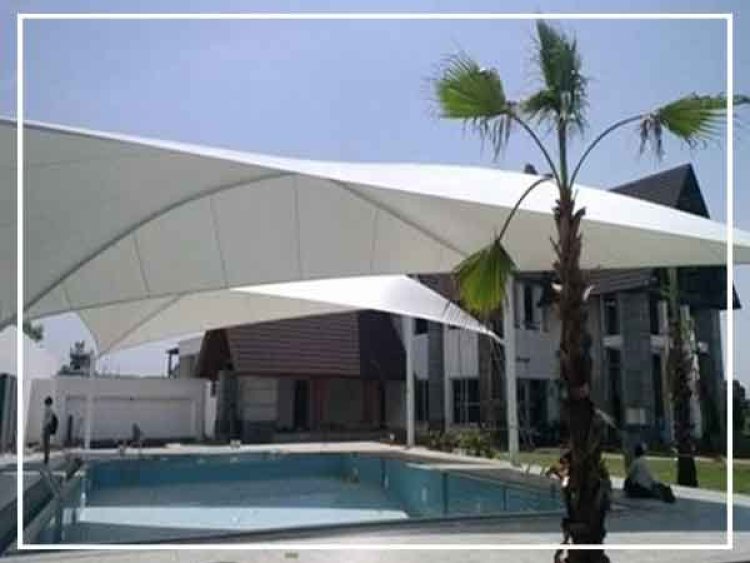Tensile Structure: Material Selection and Design Tips for Construction
tensile structures are making a strong impact. Known for their sleek appearance and strength, they are widely used in both commercial and public spaces.
Share this Post to earn Money ( Upto ₹100 per 1000 Views )
When it comes to modern architecture, tensile structures are making a strong impact. Known for their sleek appearance and strength, they are widely used in both commercial and public spaces. Whether you’re planning a stadium roof, walkway canopy, or outdoor shade, choosing the right material and design is crucial for the success of your tensile structure.
In this article, we’ll explore key material selection criteria, smart design tips, and best practices to help you build a durable, aesthetically pleasing, and cost-effective tensile structure — especially if you're working in high-demand regions like Delhi.
What is a Tensile Structure?
A tensile structure is a lightweight construction that relies on tension, rather than compression, to maintain its form. It typically uses flexible materials like fabric membranes supported by a steel framework or cables. Because of their ability to cover large areas with minimal support, tensile structures are both practical and visually appealing.
Why Tensile Structures Are Popular in Delhi and Beyond
-
Weather Resistance: Perfect for extreme heat and monsoon conditions common in Delhi.
-
Fast Installation: Ideal for quick urban or event-based projects.
-
Energy Efficient: Reflects heat, reducing the need for cooling systems.
-
Design Flexibility: Customizable shapes and colors to match modern architectural styles.
Material Selection for Tensile Structures
Choosing the right material is the foundation of any successful tensile project. Here’s what you should consider:
1. Fabric Type
-
PVC-Coated Polyester: Most commonly used due to affordability and decent durability (10–15 years lifespan).
-
PTFE-Coated Fiberglass: High strength and longer lifespan (up to 30 years), suitable for permanent installations.
-
ETFE Foil: Lightweight, transparent, and highly durable. Great for green buildings or daylight structures.
2. UV & Weather Resistance
Ensure the material has UV protection and can withstand rain, wind, and temperature changes — especially critical for tensile structures in Delhi.
3. Fire Retardancy
Use fabrics that meet fire safety standards. Most quality tensile membranes come with fire retardant properties, which is essential for public and commercial spaces.
4. Aesthetics and Color Retention
Choose a fabric that maintains color and looks fresh even after years of sun exposure. Light colors also reflect heat, which is beneficial in hot climates.
Design Tips for Durable Tensile Structures
Design plays a vital role in the functionality and appearance of your tensile structure. Follow these tips for best results:
1. Understand Load Requirements
Before choosing your material or form, assess environmental loads like wind pressure, rainfall, and snow accumulation — especially important in open or high-rise areas.
2. Optimize Shape and Geometry
Curved or conical designs are not just stylish — they help manage water runoff and wind resistance.
3. Choose Quality Framework
-
Steel (galvanized or stainless) is the preferred choice due to strength and corrosion resistance.
-
Make sure the frame complements the tensioned fabric and holds up under stress.
4. Drainage Planning
A well-designed tensile structure includes proper drainage systems to avoid water accumulation, which can lead to fabric damage or sagging.
5. Consider Local Climate and Location
In regions like Delhi, where summer heat and dust storms are common, select materials that resist dirt accumulation and are easy to clean or maintain.
Applications of Tensile Structures
-
Car Parking Shades
-
Walkway Covers
-
Stadium Roofs
-
Exhibition Halls
-
Shopping Mall Awnings
-
School & College Canopies
-
Garden and Terrace Shades
These applications are especially popular in urban centers like Delhi, where space optimization and aesthetics are highly valued.
FAQs About Tensile Structures
Q1. What is the average lifespan of a tensile structure?
Depending on the material used, the lifespan ranges from 10 to 30 years. PVC-coated fabrics offer good durability for temporary uses, while PTFE is suited for long-term installations.
Q2. Is a tensile structure suitable for all weather conditions?
Yes, tensile structures are designed to withstand various climates — from heavy rains to intense sunlight — especially when installed using quality materials and expert engineering.
Q3. How much does a tensile structure cost in Delhi?
The cost depends on the area, material, and complexity of the design. On average, prices range from ₹300 to ₹1,500 per sq.ft.
Q4. Can tensile structures be customized?
Absolutely. You can choose the shape, size, color, and even the level of transparency based on your specific needs.
Q5. Are tensile structures easy to maintain?
Yes, they require minimal maintenance. Occasional cleaning and routine inspections ensure long-lasting performance.
Conclusion
Tensile structures are not just trendy—they’re smart, sustainable, and scalable. From selecting the right fabric to designing with local weather conditions in mind, every decision counts toward building a structure that lasts and impresses.
If you're planning a project in Delhi or anywhere in India, focus on materials that offer long-term durability and design that suits your functional and visual goals. And most importantly, work with trusted experts in the industry.
Looking to install a tensile structure in Delhi or elsewhere? Explore custom design solutions and expert installation services at Ekra Decor — your trusted partner in high-quality tensile architecture.


















![Greenvow CBD Gummies Review [Scam OR Legit] Benefits Exposed? Read Pros, Cons, Working, Update 2025](https://blog.rackons.in/uploads/images/202505/image_380x226_682ebd20deb0b.jpg)